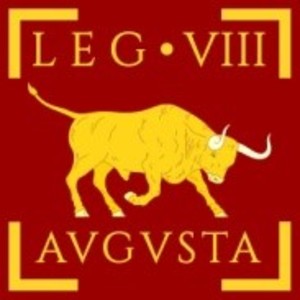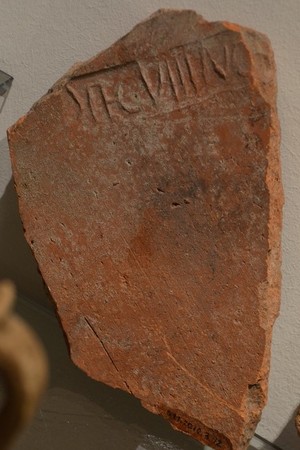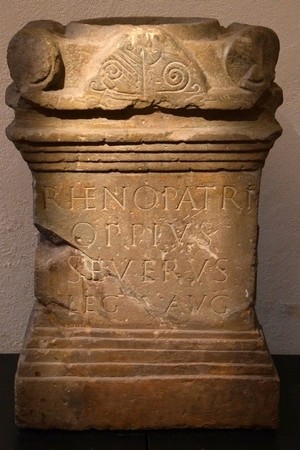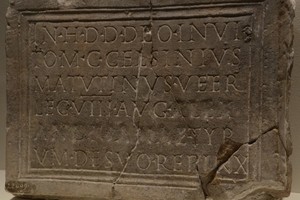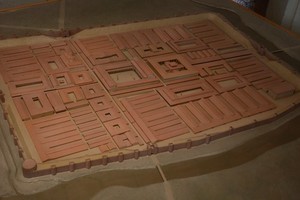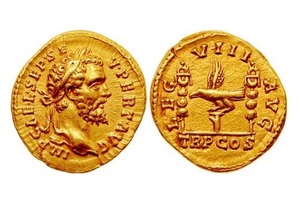Roman Legion - Legio VIII Bis Augusta
Legio VIII Bis Augusta (Eighth Legion Augusta) was a Roman legion formed by Gaius Julius Caesar.
Dates of existence: 59 BC until the early 5th century AD.
Symbol: Bull
Titles: Augusta, Bis Augusta, Pia Fidelis Constans Commoda (Forever Loyal and Honest Legion of Commodus), Pia VII Fidelis VII
Battle Path
- The legion was created by Gaius Julius Caesar to participate in the Gallic War (58-50 BC) in 59 BC. It is believed that not only Roman citizens served in the legion but also provincial inhabitants, such as the Gauls.
- The legion's baptism of fire was the Battle of the Sabis River (now the Sambre River in France and partially Belgium) in 57 BC against the Nervii tribe (one of the Belgic tribes).
- In 52 BC, the legion participated in the battle and siege of Gergovia (modern Clermont-Ferrand, France) against the leader of the pan-Gallic uprising, Vercingetorix.
- IIn the Civil War (49-45 BC) that followed the Gallic War between Caesar and Pompey, the legion sided with Caesar, participating in the Battle of Dyrrachium (modern Durrës, Albania) in 48 BC and the Battle of Pharsalus (modern Farsala, Greece) in 48 BC.
- The legion also took part in Caesar's African campaign in 46 BC, including the Battle of Thapsus (modern Ras Dimas, Tunisia) in April 46 BC. Thanks to the soldiers of Legio VIII, the Egyptian throne largely fell to Queen Cleopatra.
- In 45 BC, Legio VIII was disbanded, and its veterans were sent into retirement, given lands around Casilinum.
- In the civil war that began after Caesar's assassination in 44 BC between Caesar's supporters and his killers, Caesar's nephew, Octavian Augustus, reformed the legion, giving it the cognomen "Augusta" in the autumn of 44 BC. There is a theory that this cognomen was later given in 6 AD during its participation in Tiberius' campaign against the Marcomanni.
- In 43 BC, the legionnaires of Legio VIII Bis Augusta took part in the Battle of Mutina, and in 42 BC, in the Battle of Philippi (now near the city of Philippi in North Macedonia).
- After this battle, the legion was sent to suppress the uprising of Mark Antony's brother Lucius in the city of Perugia. The siege of the city took place in 41 BC.
- Then, under the command of Agrippa, Legio VIII Bis Augusta, as part of Augustus' army, was sent to fight Pompey the Great's son Sextus, who was holding Sicily.
- It is likely that the legionnaires participated in the second war between Octavian and Mark Antony, specifically in the Battle of Actium in 31 BC.
- There is an assumption that for its participation in suppressing Lucius' uprising, the legion received the nickname "Modenese." Another explanation for why this legion was called this for a while is lacking.
- After Octavian's final victory over Mark Antony, Legio VIII Bis Augusta was first transferred to Tunisia, then to the Balkans in 30 BC.
- In 6 AD, the legion participated in the military campaign of general and future Roman emperor Tiberius against the Germanic Marcomanni tribe.
- During the catastrophe in the Teutoburg Forest, when Rome lost Legio XVII, Legio XVIII and Legio XIX in Germany in 9 AD, Legio VIII Bis Augusta was stationed at Poetovio (modern Ptuj, Slovenia) in Pannonia.
- During Emperor Claudius' reign in 44 AD, the legion was transferred to the city of Novae (modern Svishtov, Bulgaria). Legio VIII Bis Augusta was stationed in Novae from 44 to 69 AD.
- There is a theory that one or two detachments of the legion participated in the conquest of Britain in 44 AD, but direct evidence of their participation in this campaign has not yet been found.
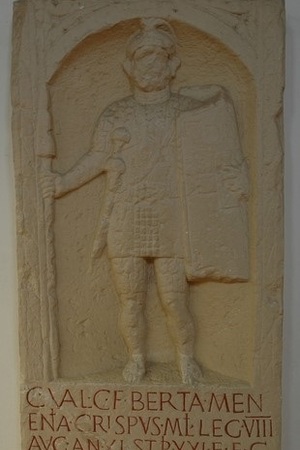 Gravestone of Gaius Valerius Crispus, legionnaire of LEGIO VIII AUGUSTA, from Wiesbaden. Saalburg Museum. Austria. Circa 90 AD.
Gravestone of Gaius Valerius Crispus, legionnaire of LEGIO VIII AUGUSTA, from Wiesbaden. Saalburg Museum. Austria. Circa 90 AD.
- During Emperor Nero's reign (54-68 AD), detachments of the legion participated in wars with the Sarmatian, Dacian, and Roxolani tribes. For this, Emperor Nero granted the legion the title "Bis Augusta" ("Twice the Augusta Legion") to the cognomen Augusta. After Nero's death, the legion refused this title.
- In the civil war that followed Emperor Nero's assassination in 68-69 AD (Year of the Four Emperors), the legion first supported Otho (ruled from January to April 69) and fought for him against Vitellius in the Battle of Bedriacum (modern Calvatone, Italy) but lost and was returned to the Danube in April 69. Soon it supported Vespasian and participated in the Battle of Cremona (June 69), where it was on the winning side.
- In 70 AD, it participated in General Cerialis' campaign to suppress the Batavian uprising on the Rhine.
- In 74 AD, Legio VIII Augusta built a road through the Kinzig Valley to shorten the route from Augusta Vindelicorum (modern Augsburg) in Raetia to Mogontiacum (modern Mainz) in Upper Germany. This marked the beginning of the occupation of southwestern Germany (modern Baden-Württemberg). Military camps were built to control the route between the Rhine and Danube, around which civilian settlements grew.
- Legio VIII Augusta may have participated in Domitian's campaigns against the Chatti in 83/84 AD and 88/89 AD. The gravestone of Gaius Valerius Crispus, found near Wiesbaden, may serve as evidence of the legion's participation in this campaign. Crispus died during this campaign and was buried near Wiesbaden.
- Legio VIII Augusta primarily performed defensive functions on the Rhine for a long time. Here they defended the border from the Germans, controlled Rhine shipping, built roads, new fortresses—forts—and sometimes engaged in civilian construction, such as building an aqueduct in Argentorate (now Strasbourg, France) and more. During their long stay at the fortress in Argentorate (now Strasbourg, France), the legion established its own pottery production with its stamp, and later archaeologists would find ceramic bricks and tile fragments with the legion's stamp in this area.
- A large detachment of the legion of 1,000 men was also sent to Britain to build Hadrian's Wall in 119 AD.
- In 130 AD, the legion's commander received the title Pater Rhenus (Father of the Rhine) for his merits.
- In 185 AD, the legion destroyed the rebel Maternus and his gang.
- In 186 AD, the legion received the title Pia Fidelis Constans Commoda ("Forever Loyal and Honest Legion of Commodus").
- After Emperor Commodus' death in 192 AD, the title was shortened to Pia Fidelis Constans.
- In the year of the Five Emperors (193 AD), the legion immediately sided with Septimius Severus and suppressed the rebellion of Clodius Albinus (193-197 AD) in Lugdunum (modern Lyon, France).
- In 196-197 AD, the legion participated in Emperor Septimius Severus' Parthian campaign.
- In 213 AD, during Emperor Caracalla's reign, the legion participated in a military campaign against the Germanic Alemanni tribe.
- In 233 AD, during Emperor Alexander Severus' reign, the legion participated in a military campaign against the Sassanids in the East.
- In 235 AD, Legio VIII Augusta was returned to the Rhine to defend against the Germanic Alemanni tribes attacking the Roman provinces on the Rhine.
- Between 250 and 260 AD, the Alemanni managed to capture Roman territories between the Danube and the Rhine, and Rome retreated from these territories, but Legio VIII Augusta continued to guard the Rhine border.
- During Emperor Gallienus' reign, the legion received the title Pia VII Fidelis VII for supporting him against Postumus. After Emperor Gallienus' death, the title granted by him was rarely used in the legion.
- In the 4th century, a large detachment of the legion was stationed in Divitia (modern Deutz, Germany), but the main forces of the legion continued to be located in Strasbourg.
- In the 5th century, the legion is mentioned in the Notitia Dignitatum as "OCTAVANI," being part of the palatine legions.
- In 402 AD, Legio VIII Augusta, along with other forces, was summoned by General Stilicho to Rome to defend it against the Visigoth troops of Alaric.
- Further information about the legion and its fate is unknown.
Related topics
List of Roman Legions, Legion, Legionnaire, Gaius Julius Caesar, Octavian Augustus, Year of the Five Emperors, Notification Dignitatum, Legio XVII, Legio XVIII, Legio XIX
Literature
1. Dandelot-Collins. Legions of Rome.
2. R. Kanya. A brief history of the various legions.
3. S. Mitchell, "Legio VIII and the Garrison of Augustana Galatia", in: Classical Quarterly 26 (1976) 298-305
4. M. Redde, "Legio VIII Augusta", in: Jan Le Bogue, Roman Legion of the Empire (2000 Lyon) 119-12
